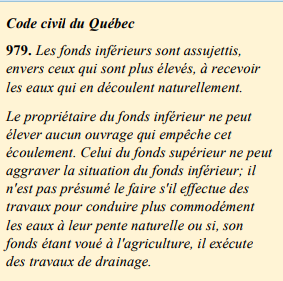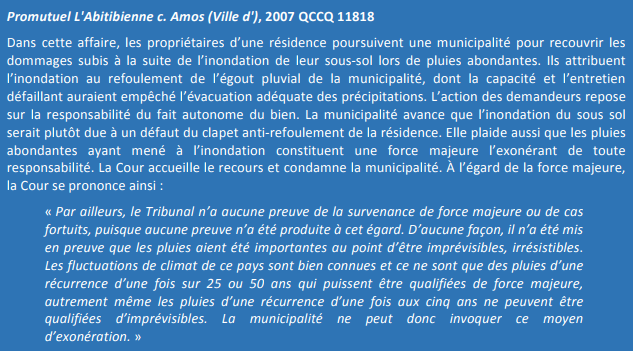Water Law: Managing Usage Conflicts Caused by Hydrological Variability
The project identified concrete legal mechanisms for dealing with exceptional hydrological variations as well as their benefits and limitations in the context of climate change.
Project details
Principal(s) investigator(s)

Context
Hydrological variability refers to changes in the water regime, from day to day or season to season, as well as year-to-year and decade-to-decade fluctuations. It can occur as a result of common or rare meteorological events. In Québec, it generally takes the form of flooding and periods of drought. Often unpredictable, they impose considerable uncertainties that must be dealt with.
Global warming affects climate variations and extreme meteorological events, thereby increasing the uncertainty of hydrological forecasts. That being said, hydrological variability creates issues for the Québec legal system, which has specific rules governing the management and use of water.
This project therefore seeks to identify certain inherent constraints that the law imposes on water resources management and on climate change adaptation in the context of fluctuations in the water regime.
Objective(s)
-
Establish a general definition of the phenomenon of hydrological variability to serve as a basis in the context of a legal study;
-
Identify the law applicable to phenomena related to hydrological variability;
-
Analyze current law regarding the management of hydrological variability;
-
Identify conflict management mechanisms.
Methodology
-
Based on a literature review, draw a general portrait of hydrological variability that highlights the relevant characteristics as part of a legal study;
-
Research sources of positive law (the set of all legal rules currently in force) in Québec. Analyze the laws, regulations, jurisprudence, legal doctrine and administrative documents produced by government authorities;
-
Compare the characteristics of hydrological variability to the characteristics of the applicable legal framework and study the constitutive mechanisms of the law to establish its limitations as a normative framework for hydrological variations.
Results
Several observations emerge from the study of water-related usage conflict management measures in the context of hydrological variability.
First of all, hydrological variability causes damage to another and, as such, the legal recourse available before the courts primarily falls under general law, such as a servitude of flow (owners must allow water to flow, without aggravating the servitude), abnormal neighbourhood disturbance, remedy for depletion, autonomous act of a good, etc.

979. Lower land is subject to receiving water flowing onto it naturally from higher land.
The owner of lower land has no right to erect works to prevent the natural flow. The owner of higher land has no right to aggravate the condition of lower land, and is not presumed to do so if he carries out work to facilitate the natural run-off or, where his land is devoted to agriculture, he carries out drainage work.
In general, these remedies have a curative effect (aimed at correcting or restoring a situation). They come into play after the damage has occurred. Among them, only remedy for depletion can be used in a preventive capacity. In the case of an autonomous act of a thing, the custodian of the thing (the person who has the power to control and manage the thing, and who has therefore the possibility of preventing the damage caused by the thing) can cite efforts made to prevent the act causing damage (for example, flooding) to prove that he is not at fault.
As none of these remedies have a punitive effect, they are not always sufficient to encourage action to limit the impact of hydrological variability on others. These tools target generic sets of situations that do not explicitly take into account hydrological variability. This shortcoming makes them imprecise management tools.
However, it is important to keep these tools imprecise because statutory law will never be able to predict all possible events, especially in a context in which hydrological variability is changing and becoming less predictable due to climate change.

The degree of instability in the application of the law depends in part on the familiarity of the legal community with the hydrological sciences and the frequency of disputes related to variations in the water regime. However, there is a need for a statutory framework (specific laws) that is as precise as possible in order to minimize the number of cases going before the courts.
It is a case of two solitudes. On the one hand, the legal system can be difficult to understand for non-lawyers, and on the other hand, legal experts have little scientific knowledge about hydrological variability. The system allows judges a certain amount of room for interpretation, for example, in the use of the legal standards of “normal disturbance” or “reasonable person”, standards that might evolve differently for scientists with a better understanding of hydrological variability.
Furthermore, in a situation of force majeure, the courts continue to use a historical—rather than scientific—approach.
Finally, legal remedies must be considered across the entire legal water management framework in order to offer an appropriate perspective on the role they play, the limitations they impose on the taking into account of hydrological variability, and the possibility of reform to which they could be subject. Upstream of the courtroom, statutory law regulates most aspects of usage conflicts through preventive measures designed to avoid the most problematic situations.
Benefits for adaptation
The project identified concrete legal mechanisms for dealing with exceptional hydrological variations as well as their benefits and limitations in the context of climate change. This initial analysis helped to better define the issues and will guide further research on the topic.
Scientific publications
Funding



Other participants
-
Direction de l’expertise hydrique du Québec
-
Fondation du Barreau du Québec
-
Hydro-Québec
-
Ministère du développement durable, de l’environnement et de la lutte aux changements climatiques